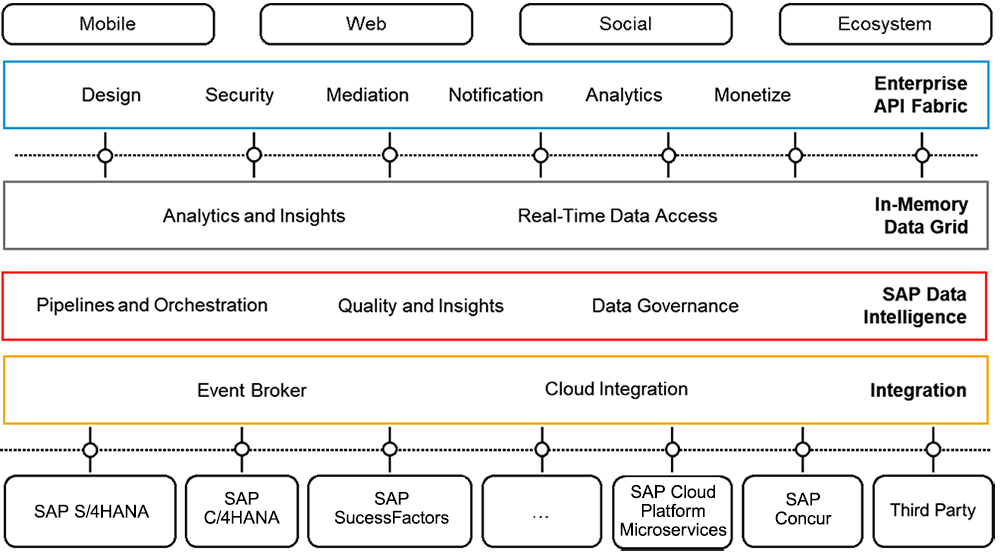How a Digital Integration Hub Is a Business Game-Changer in the Experience Economy
by Keith Grayson, Senior Director, SAP Cloud Platform Integration Suite Product Management, SAP, and Paul Medaille, Director, SAP Cloud Platform Integration Suite Product Management, SAP
Imagine that you are an executive with a major sports team — during normal times rather than the current COVID-19 environment — and you are hosting tens of thousands of fans in your venue every week. To ensure profitable operations, you must safeguard and optimize many different sources of revenue, including ticket sales, luxury box rentals, parking, concessions, and merchandise. And while a competitive team and exciting games tend to be the biggest revenue drivers, there is another area that can have a significant impact on your business success: the fan experience in your stadium or arena.
A scenario such as game day for a major sports team, where everything is happening in the moment, can present a range of challenges when it comes to delivering the best possible fan experience. How do you ensure that there are no bottlenecks in the parking lot, that there are no long lines at the concession or merchandise stands, and that everything and everybody are in the right place as situations change throughout the day? To stay informed and to act in such a fluid environment, you need up-to-the-minute information from a myriad of systems, such as customer engagement, parking control, point of sale (POS), merchandising, ticket sales, and experience management systems.
This was the situation facing the San Francisco 49ers, a franchise of the US National Football League. To support its goal of delivering the best possible game-day experience to fans, the organization built out an executive command-and-control cockpit called Executive Huddle. Based on “digital boardroom” technology from SAP, this cockpit was installed in a luxury box at Levi’s Stadium in Santa Clara, California. By using SAP Cloud Platform Integration Suite, the organization was able to integrate data in real time from several cloud-based and on-premise sources — including ParkHub, Sparkcentral, MICROS, and Fanatics — and aggregate that data in SAP Analytics Cloud to present an integrated view to decision makers via the Executive Huddle cockpit. The organization can also integrate the Twilio communication platform with the cockpit to enable executives to react to changing circumstances in real time by texting instructions to employees, which helps improve business outcomes and the fan experience. The Executive Huddle initiative was a featured SAP Innovation Award winner in the Digital Trailblazer category in 2019, and the entire project was completed in just six months.
Of course, not only sports teams face the challenges presented by a rapidly evolving business environment. The same principles apply to any organization, where your products and services are the team you field, every day is game day, and the time to act is now. With the sports team example in mind, let’s look at what comprises a Digital Integration Hub and how it delivers excellence at scale and tangible business value.
What Is a Digital Integration Hub?
Creating a coherent digital view to power a digital boardroom such as Executive Huddle requires data that is gathered across many systems in real time. The systems involved are likely a combination of new cloud-based application services as well as traditional on-premise applications, such as POS systems. Some may be in-house applications, while others will be outsourced cloud applications. When creating reports on dashboards, users want to be able to create different views of data in a consistent way. The best way to do that is for organizations to provide a consistent approach for the interfaces through which the user-facing applications consume data.
SAP customers are increasingly following this approach by using application programming interfaces (APIs) and adopting an API-first approach to integration. Keep in mind that an API-first approach isn’t just about standardizing on a technical API management platform. While the ability to enforce security standards, enable a high level of governance, and access utilization and performance analytics are certainly valuable — as is the focus on standard integration with HTTP-based protocols such as REpresentational State Transfer (REST), Simple Object Access Protocol (SOAP), and OData — a transformation in mindset about integration is equally important.
With an API-first mindset, the focus moves away from the minutiae of integration technicalities and toward the business data services that are required to deliver the necessary executive operational insights. Executives decide on the information they need in their real-time dashboards to keep customers happy, which needs to be translated to the set of connected systems providing that data. There needs to be a team that is responsible for delivering the required information as a digital business service API that can be easily consumed by the dashboard applications. It may be that the data identified by executives is not available through the current systems, and if so, a requirements-gathering process is necessary to find out how to get this data. For example, in the case of the sports team, could it come from a mobile “fan” app? Could it come from social media? Is a new customer survey required to get experience data?
A standardized, extensible platform for integration enables organizations to ask these questions without becoming trapped in an extended discussion about which integrated system data should be displayed on the dashboard. An integration platform allows organizations to approach these types of questions as business challenges rather than technical challenges. That said, technical challenges will still exist, and the team that is building and maintaining the executive dashboards — and the platforms that drive them — will require the skillsets of a variety of roles, including those of business requirements analysts, business process experts, analytics and dashboard developers, mobile app developers, integration engineers, and application experts. At first glance, this may sound difficult and labor-intensive — however, it need not be. This is where SAP Cloud Platform comes in — providing the tools required to create a coherent solution that caters to these skills, including user interface, event orchestration, data correlation, and integration functionality.
Better Performance
In a typical “API first” platform, the application clients interact with individuals using APIs through the API management layer, which proxies API calls from the application client and delivers digital business services to the back-end systems of record, data lakes, and databases. This type of strategy can create challenges when deployed at scale. Where client applications are deployed to many end users with unpredictable usage, or where APIs can be subjected to high load conditions, a couple of issues can arise: 1) long round-trip latencies from the client application request to the response from the back-end systems; and 2) scalability of back-end systems servicing many repetitive requests, for which they were not necessarily designed.
A “Digital Integration Hub” architecture can address these challenges by inserting a high-performance, in-memory database between the back-end systems and the API management layer. This database helps customers in three main ways:
- For APIs that return data to analytical services, the database can act as a cache of data for requests. In this role, for the requests that can be processed in the database, there is a fast turnaround with little latency compared to referring to the back-end applications and database layer.
- Every request handled through the database using cached data reduces the load on the back-end applications and other systems of record, preventing them from becoming overloaded.
- The residual load on back-end applications and databases will be reduced due to the servicing of most requests from the database, thus avoiding overloading.
Customers that have implemented a Data Integration Hub architecture using SAP Cloud Platform Integration Suite with SAP HANA in the cloud have noticed close to a 10x increase in performance when it comes to reducing response times to requests. In addition, they note better scaling to support increased loads and throughput.
Improved Data Quality
Having addressed performance, the next point to look at is how to populate the database with valuable data packaged into digital business services. Adding a database to create a Digital Integration Hub does not necessarily improve the quality of data-driven services that can be delivered to APIs. In fact, it can compound the challenges of delivering services that comprise data from different sources.
Introducing a data intelligence layer into the architecture can help address this by aggregating data, which may change at different speeds, from multiple sources into the database. This data can include streamed data for preventative maintenance scenarios and combinations of operational and experience data for 360-degree customer views. It can also include information for finding the best-fit personnel for specific roles, to perform predictive maintenance on complex machinery, to assess credit risk, and more.
SAP Data Intelligence provides a bridge between the worlds of data scientists and business process analysts (see Figure 1). This solution can create insights by combining data from multiple sources and curating and enriching combinations of structured data, image processing, video recognition, and other streamed data sources. It can also apply machine learning algorithms to correlate these data sources and deliver meaningful insights and data to an SAP HANA data platform, accessible by analytical applications through APIs.

Figure 1 SAP Data Intelligence aggregates data into a high-performance, in-memory database and creates the foundation for a Digital Integration Hub
Combining an in-memory database with business intelligence on a standardized, extensible platform for integration creates what Endress+Hauser, an SAP Innovation Award finalist in 2020, calls a “Business Data and Integration Hub (BDIH).” Endress+Hauser, which focuses on industrial instrumentation, has used SAP Data Intelligence to evolve from maintaining data siloes to following an approach centered on “data thinking.” According to the company, “The BDIH is the new foundation for our intelligent enterprise enabling new innovative solutions.”
Opening New Lines of Communication with Your Customers
Anything and everything you can do to bring your customers closer provides significant benefit to your business. Everything that improves the customer experience — that eliminates transactional friction, accelerates sales, and makes it easy to do business with you — increases the chances that you will grow and retain your customer base.
Centrica plc — a British multinational energy and services company, a supplier of electricity and natural gas to millions of customers, and an SAP Innovation Award nominee in 2020 — wanted to provide digital access to customers to improve service, lighten the load on call center staff, and increase customer satisfaction. With 10-year-old back-office systems, the company didn’t want to wait for a lengthy upgrade process to improve its business, so it turned to SAP Cloud Platform to implement a Digital Integration Hub to connect customers in real time.
Centrica adopted an API-first integration strategy to expose data-heavy services to customers, and it leveraged open connectors from SAP to provide easy connectivity to non-SAP applications and services. Leveraging SAP HANA as the in-memory database in SAP Cloud Platform, the company reduced SAP solution query response runtime from 1.8 seconds to less than 200 milliseconds. Now, Centrica handles 5-7 million API calls per day through its digital channels, significantly reducing the load on its call center. The business also raised its Net Promoter Score (NPS) for customers that use the digital channel by five points — when compared to customers that manage their accounts offline.
Another SAP Innovation Award nominee in 2020 is the legendary British department store Harrods, which wanted to give its customers a new way to shop via a high-fashion, web-based marketplace. This required a standardized approach to enable connectivity to several systems across multiple technologies and vendors. The company’s existing integration environment was a single, non-resilient middleware component that was complex and difficult to maintain.
For Harrods, the solution was to adopt a cloud-based IT strategy for integration, leveraging SAP Cloud Platform Integration Suite to provide standardized integration with third parties through a searchable set of published APIs, and deliver both partner connectivity and seamless integration to on-premise systems. The company was able to deliver this new integration infrastructure in just three months, leveraging a lean team of four employees supplemented by niche experts in back-end APIs. This team deployed more than 100 integration flows to production. Now, Harrods processes three million transactions per week through its digital channel, which allows it to simplify business operations and extend into new markets, such as China and Saudi Arabia.
Eliminating Paper Jams and Improving Business Outcomes
The tarmac at a busy international airport is a bustling environment. It is complex and chaotic, and every day is “game day” — even more so at usual volumes, when the world is not in crisis. Regardless of capacity numbers, airlines need to keep turnaround times for airplanes to a minimum by unloading passengers and baggage, cleaning and refueling, and loading passengers, baggage, and catering as quickly as possible. Precious seconds wasted in the refueling process, for example, can cause delays, which in turn cost money. Delays and associated costs are practically inevitable when organizations use antiquated paper-based systems — for instance, an unexpected gate change could leave refueling crew members scrambling to figure out where they need to be.
To keep up with this type of fast-paced environment, Shell Aviation developed a mobile cloud-based application to automate the ticketing process for airplane refueling operators. The SkyPad app, built on SAP Cloud Platform, is used at the airport apron — that is, the location where loading, boarding, and refueling happens — to digitize end-to-end operations and transfer data in real time between the back-end systems and airport operations. Through SAP Cloud Platform Integration Suite, the app handles stock and tank farm management, reconciliation and reporting to local bodies, and staff rostering, as well as integration with airlines, the e-commerce platform, static and dynamic flight schedules, and multi-fuel provider delivery systems. In short, by leveraging the app on a tablet, the daily work of the airport refueling operator is streamlined, more efficient, and less error prone. Shell Aviation reports that the SkyPad app has reduced refueling transaction times by approximately 13.3 hours per day per airport.
Many organizations still have paper-driven processes that hamper efficiency and slow the business, reducing productivity, profitability, and employee and customer satisfaction. Eliminating paper-based processes is a no-brainer in a digital economy.
Imagination Plus Integration Equals Innovation
Companies looking to improve business processes and wring more value out of their IT investments can turn to integration technology that simplifies development while delivering new capabilities. Organizations of all sizes, industries, and regions can combine imagination with integration — and bring innovation and real value to the company — by leveraging integration technology to:
- Transform their business with fast, focused projects that deliver high value and low total cost of ownership
- Digitize paper-based processes, reducing costs and increasing efficiency
- Create cross-system processes that span multi-vendor hybrid landscapes
- Develop new sales channels and new ways to reach customers directly
- Gain real-time insight into their business, increasing agility and improving outcomes
- Deliver self-service capabilities to customers, freeing employees for more productive activities
This article shares a few — among many — stories about how implementing a Digital Integration Hub, an API-first integration strategy, and a data-centric mindset have helped creative teams overcome perceived limitations and deliver innovative business process improvements, increased customer satisfaction, and new revenue sources to their respective businesses. At the nuts-and-bolts level, this is the essence of digital transformation.
This is just one way that the game is changing for IT organizations willing to embrace a new way of delivering value to the business. The possibilities are endless and evolving, and business success is waiting just down the road. To get in the game and find ways you can apply imagination plus integration in your environment to field a winning team of new business services, visit here.

Keith Grayson is a Senior Director of Product Management at SAP, responsible for go-to-market and evangelism of SAP Cloud Platform Integration Suite. Keith has been with SAP for 12 years; before joining SAP, he had been working in the technology industry for 19 years for both large companies and startups.

Paul Medaille has more than 20 years of experience working with SAP technology as an educator, consultant, solution manager, and product manager. He joined the SAP Cloud Platform Integration Suite product management team in November of 2019.
Note: Divya Mary, Product Manager of SAP Cloud Platform Integration Suite at SAP, contributed many of the ideas developed in this article.




